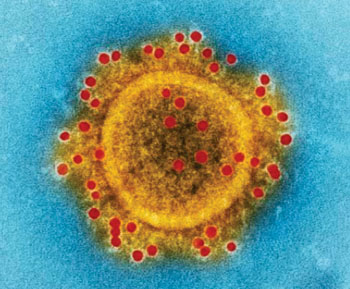Serological Assays Compared for MERS-Coronavirus Infection
By LabMedica International staff writers
Posted on 28 Oct 2015
Middle East respiratory syndrome (MERS) poses a major threat to global public health and validated serological assays are important for diagnosis and for seroepidemiology to define prevalence and risk factors. Posted on 28 Oct 2015
Serological assays for detecting antibody for MERS-coronavirus (CoV) infection include antibody arrays, enzyme-linked immunosorbent assay (ELISA), immune-fluorescence, microneutralization (MN), plaque reduction neutralization (PRNT) and MERS-spike pseudoparticle neutralization tests (ppNT).

Image: Transmission electron micrograph (TEM) highlights the particle envelope of a single, spherical-shaped Middle East Respiratory Syndrome Coronavirus (MERS-CoV) virion (Photo courtesy of US National Institute of Allergy and Infectious Diseases).
Scientists at the Seoul National University College of Medicine (Republic of Korea) and their colleagues in Hong Kong tested 95 sera from 17 patients collected two to 46 days after symptom onset with real-time reverse transcription polymerase chain reaction (RT-PCR) confirmed MERS-CoV infection diagnosed during an outbreak of MERS in South Korea. They compared the RT-PCR results with PRNT antibody titers using 90% (PRNT90) and 50% (PRNT50) plaque reduction end points, MN, MERS-spike ppNT and S1-ELISA tests. The sera were also used to investigate the antigenic similarity of three genetically diverse strains of MERS-CoVs. The authors had previously reported that early PRNT50 and S1-ELISA antibody responses in this patient-cohort were associated with improved clinical outcome.
The MERS-CoV strains used in the virus neutralization assays belonged to clade A (MERS-CoV-strain EMC), clade B (dromedary camel MERS-CoV Al-Hasa FKU-HKU13 2013) as well as a virus from a distinct non A and B clade (dromedary camel Egypt NRCE-HKU 270 2013). The PRNT assays were performed in a 24-well format in duplicate for each serum dilution. Antibody titers were defined as the highest serum dilutions that resulted at ≥ 50% (PRNT50) and ≥ 90% (PRNT90) reduction in the number of plaques, respectively. The S1 ELISA EI 2604–9601G kit (EUROIMMUN; Luebeck, Germany) was used for detection of human immunoglobulin G (IgG) against MERS-CoV.
The different virus neutralization assays (MN; ppNT PRNT50; PRNT90) all had excellent correlation between them. The PRNT50 antibody test was more sensitive in detecting early antibody responses and had higher antibody titers throughout, as would be expected, given the less stringent end point of ≥ 50% reduction of plaque numbers, in contrast to the ≥ 90% reduction of plaques needed for the PRNT90 antibody titer endpoint. The semi-quantitative optical density (OD) ratios of the MERS S1 ELISA had acceptable but lower Spearman correlations with the different neutralization tests, in terms of the time to becoming positive in patients with MERS.
The authors concluded that the different types of neutralization or ppNT assays can be used in MERS-CoV diagnosis and seroepidemiology. PRNT50 was more sensitive than other assay formats and may be the only assay that can be positive early in the course of infection and in a few patients with poor serologic responses. Genetically diverse MERS-CoV are antigenically homogenous suggesting that future vaccines generated by any MERS-CoV strain will cross-protect against genetically and geographically diverse viruses. The study was published on October 15, 2015, in the journal Eurosurveillance.
Related Links:
Seoul National University College of Medicine
EUROIMMUN














